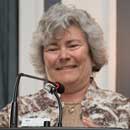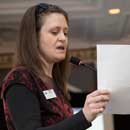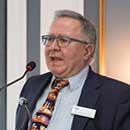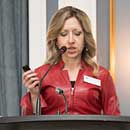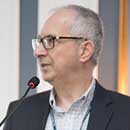This year’s Plenary Session of the APEGS Annual Meeting featured a series of “lightning talks” – five mini-presentations limited to seven minutes in length.
Continuing Professional
Development Reporting
Shawna Argue, P.Eng., MBA, FEC, FCSSE, FGC (Hon.), APEGS Director of Registration, gave a talk on the proposed changes (confirmed at the Business Meeting) to Continuing Professional Development (CPD) requirements for APEGS members. The biggest change is the move to mandatory reporting. The changes also require a more precise breakout of hours in the various categories with new minimums and maximums of hours that can be claimed in those categories. There is a further requirement for a regular ethics refresher course.
If members are unable to meet their requirements for personal or professional reasons (e.g. a parental leave or a sabbatical), they may apply for a “variation” – essentially a waiver on their requirements for a specified period of time.
If members fail to complete their CPD requirements without good cause, the main response from APEGS will be that APEGS staff will work with you to help bring you back into compliance. Only in the most extreme cases of a member refusing to comply would APEGS consider revoking the member’s licence. Those of APEGS’s sister organizations that have long-standing mandatory CPD have reported that revocation has only had to be used once or twice for the most stubborn cases of refusal to comply.
Competency-Based
Assessment
Tina Maki, P.Eng., FEC, FGC (Hon.), APEGS Director of Special Projects, stole the show at the lightning talks with her presentation which she dubbed “Competency Karaoke.” Maki sang her presentation to the tune of M.C. Hammer’s “Can’t Touch This.” Maki’s vocal stylings were so engaging that few in the audience were able to focus on the content of the presentation, but everyone came away with the understanding that competency-based assessment is cooler than it sounds, is not scary and that more information was available at a booth throughout the Annual Meeting.
Following this presentation, all successive presenters felt compelled to apologize for not preparing a song.
Ethics and Social Media
Bob McDonald, P.Eng., APEGS Executive Director and Registrar, gave a presentation on the ethical pitfalls of social media. McDonald noted that social media is nothing new. Essentially, all forms of media – from the earliest cave paintings to the invention of the printing press to letters to the editor – are social media to one degree or another. Professionals have always had to be cautious about what they say or write in public in case their words are interpreted as defamatory or unprofessional. The distinguishing factors of today’s online electronic social media are their speed and abundance. Reputational damage happens faster through social media and can be much harder to fix. Some professionals are under the illusion that their personal social media accounts are protected as free speech and not subject to professional ethics regulations. The courts have consistently deferred to regulators on this matter, such as the case of the nurse who was disciplined for making disparaging comments about the health care system on her personal social media account.
Strategic Communications Planning
Communications and public relations are an increasing concern for APEGS as an organization and for APEGS members individually. APEGS Manager of Communications Sheena August outlined the nine steps to effective strategic communications.
The first is to analyze the communications situation. Why do we want to communicate? What are the risks if we don’t or do so in the wrong way?
Second is to analyze the organization by conducting a thorough SWOT analysis of the organization’s strengths, weaknesses, opportunities and threats.
Then the organization must determine the audiences it wishes to reach and the nature of those audiences.
As with any undertaking, a communication plan must set out clear and measurable goals and objectives. On the basis of those goals, it must formulate the actions it will take as well as an overall message strategy.
With the strategy in place, the organization can then begin to select tactics such as advertising, one-on-one discussions, media events, social media or any of the numerous other communications tools. Of course, once you have determined the tactics, then you have to go out and implement them.
Finally, once the strategy and tactics have been carried out, it is imperative to evaluate their effectiveness.
Digital Signatures and Authentication
If you work in an office, the odds are you hate paper. It stacks up, it’s hard to track and it’s a pain to store. Yet many offices continue to keep volumes of paper because they believe that original signed documents carry special legal weight.
Fred Mazzarello, the business solutions director at Notarius, offered a solution to the paper mountain. Notarius specializes in electronic authentication systems such as digital signatures which provide greater certainty of the source of the document and identities of the signators than paper documents. Originally founded by the professional notaries association of Quebec, Notarius prides itself on systems that meet the highest legal standards of document verification. Their clients include seven provincial engineering and geoscience associations and numerous engineering and geoscience companies.
